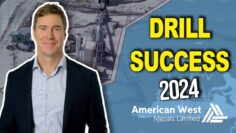{australien_flagge}What American West (ASX: AW1; FRA: R84) geologists previously only suspected, they have now seeing evidence of through gravity surveys: Directly beneath the near-surface copper blanket of their previous drill target 4100N on the Storm Project in Nunavut is the potential for a much larger sediment-bound copper system. American West refers to this as a ‘Mother Lode’ copper target at the Storm copper project, Canada. Gravity anomalies start about 200 meters below surface and have a strike of several kilometers. Shares reacted to the breakthrough results in Australian trading with an almost 34 percent gain.
{australien_flagge}What American West (ASX: AW1; FRA: R84) geologists previously only suspected, they have now seeing evidence of through gravity surveys: Directly beneath the near-surface copper blanket of their previous drill target 4100N on the Storm Project in Nunavut is the potential for a much larger sediment-bound copper system. American West refers to this as a ‘Mother Lode’ copper target at the Storm copper project, Canada. Gravity anomalies start about 200 meters below surface and have a strike of several kilometers. Shares reacted to the breakthrough results in Australian trading with an almost 34 percent gain.
Dave O’Neill, Managing Director of American West Metals, commented, “The recent gravity survey over the Storm project area has delivered spectacular results. The data confirms our geological assumptions and the potential for a large copper system beneath the near surface copper mineralization. The high-resolution survey has successfully defined a series of large, dense bodies that lie directly beneath the high-grade 4100N zone and in key areas around the other known high-grade copper deposits. Importantly, our interpretation of the gravity data is supported by coincident historical geophysical anomalies and the 2023 discovery of copper sulfides in drill hole ST22-10, which is on the periphery of one of the newly identified gravity targets. We’re on the hunt for big copper targets here.”
Meanwhile, resource drilling of the near-surface copper is progressing very well. David O’Neill is confident that American West will deliver a significant and robust maiden copper resource at Storm based on these results alone. The new copper targets at depth are a new factor that once again redefines Storm’s potential. American West is giving high priority to drilling these targets in the ongoing 2023 field program.

Figure 1: Interpretation of gravity data showing 3D gravity targets, known copper sulfide occurrences, and major faults (with overlying topography). The gravity survey has defined a series of dense structures spatially associated with the interpreted graben fault architecture and known copper sulfide mineralization at Storm.

Figure 2: East-west long section of the 4100N zone. The near-surface drill holes designed to define an initial resource can be seen well. The large density anomaly (red) can be seen below. This structure is approximately 2.3 kilometers long and extends to a depth of more than 500 meters.
Indications of sedimentary copper deposits at depth
The recent gravity survey and contemporaneous historical geophysics have revealed the potential for a very large sediment-bound copper system at Storm. In addition, the data provide a new interpretation of last year’s deep drill hole ST22-10. Exploration hole ST22-10 was completed in 2022 and targeted a large EM anomaly west of the near-surface high-grade 4100N zone. Three-dimensional interpretation of the 2023 gravity data indicates that hole ST22-10 intersected only the top of the large dense body below the 4100N zone, making it an important target for the discovery of additional copper sulfides. The geology, mineralization, geophysical response and structural setting are similar to many of the world’s major sedimentary copper systems, including the Kalahari Copper Belt (Botswana) and Central African Copper Belt (DRC, Zambia) deposits.
Interpretation has highlighted a series of NW-SE oriented gravity anomalies along the main axis of the Storm faults, which are discontinuous and partially displaced due to a series of N-S oriented faults. The ‘southern fault’ gravity anomaly is approximately 4 km long, lies south of the trench fault and is bounded by the high-grade 3500N, 2750N and 2200N copper zones. The ‘Northern Fault’ gravity anomaly extends for about 4.8 km, lies north of the main fault and is divided into two main zones. The easternmost zone is directly beneath the 4100N zone where ongoing drilling has defined thick and continuous copper mineralization near surface over a 1km strike.
The largest of the 3D gravity targets is located along the northern fault and immediately below the 4100N Zone (Figures 6 to 8). The feature begins at about 200 m depth and is about 2.3 km long. The gravity feature is intersected by a strong historical IP anomaly at its upper contact. This is a highly significant connection and suggests a dense and electrically chargeable body. The only known chargeable geologic feature at depth in the Storm area is sulfides.
A series of gravity targets have also been defined by 3D inversion along the southern fault. The data indicate that a strong gravity target is approaching surface to the west of the 2750N high grade copper zone. This location also has strong EM and IP anomalies associated with known copper mineralization in sparse, near surface historical drilling (5 m @ 2% Cu and 0.8 m @ 20% Cu in hole ST00-66).
CONCLUSION: American West has identified the potential for a type of copper deposit in the Arctic Archipelago west of Greenland with geological characteristics consistent with typical sedimentary large copper deposits in central and southern Africa. As it stands, the holes drilled so far on the various zones 4100N, 2200N and 2750N were just the proverbial scratching of the surface. But these holes alone will very likely deliver a first resource this year and already define a stand-alone project with DSO potential. However, the new insights now gained catapult American West into the Champions League of copper projects at a stroke. The potential is huge. Especially considering that Storm covers only a fraction of the more than 4,000 km² exploration license. Today’s results should not only please shareholders, but also have aroused the interest of the majors.
Disclaimer: GOLDINVEST Consulting GmbH publishes comments, analyses and news on https://www.goldinvest.de. These contents serve exclusively the information of the readers and do not represent any kind of call to action, neither explicitly nor implicitly they are to be understood as an assurance of possible price developments. Furthermore, they in no way replace an individual expert investment advice, it is rather promotional / journalistic publications. Readers who make investment decisions or carry out transactions on the basis of the information provided here do so entirely at their own risk. The acquisition of securities, especially with shares in the penny stock area, carries high risks, which can lead to a total loss of the invested capital. The GOLDINVEST Consulting GmbH and its authors expressly exclude any liability for financial losses or the content guarantee for topicality, correctness, adequacy and completeness of the articles offered here. Please also note our terms of use.
According to §34b WpHG and according to paragraph 48f paragraph 5 BörseG (Austria) we would like to point out that principals, partners, authors and employees of GOLDINVEST Consulting GmbH hold or may hold shares of American West Metals and therefore a possible conflict of interest exists. We also cannot exclude that other stock letters, media or research firms discuss American West Metals during the same period. Therefore, symmetrical information and opinion generation may occur during this period. Furthermore, there is a consulting or other service contract between American West Metals and GOLDINVEST Consulting GmbH, which means that a conflict of interest exists.













